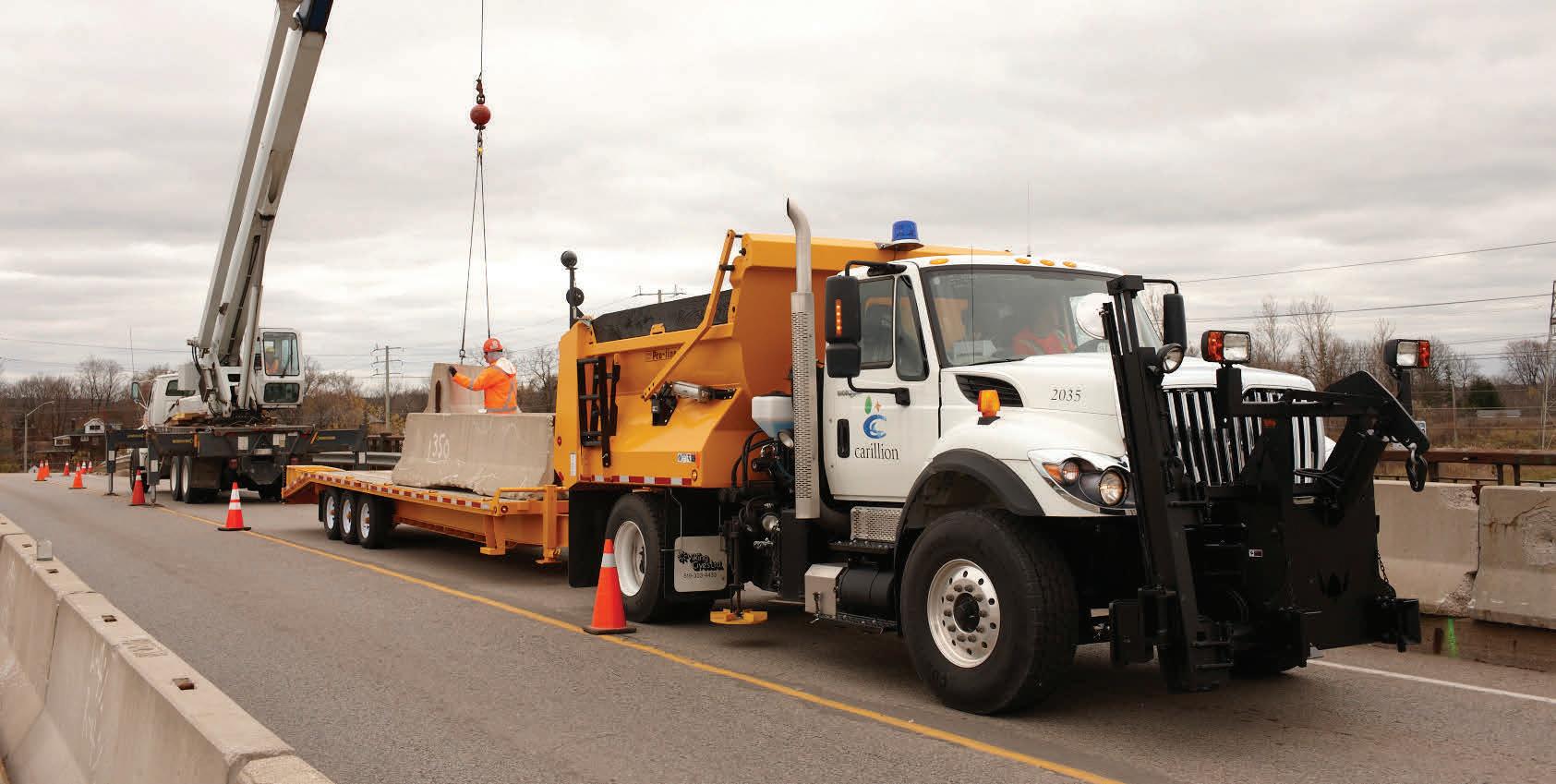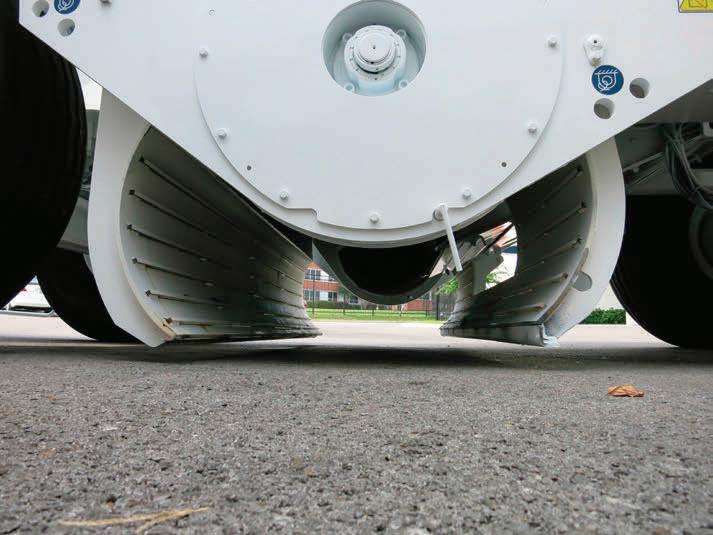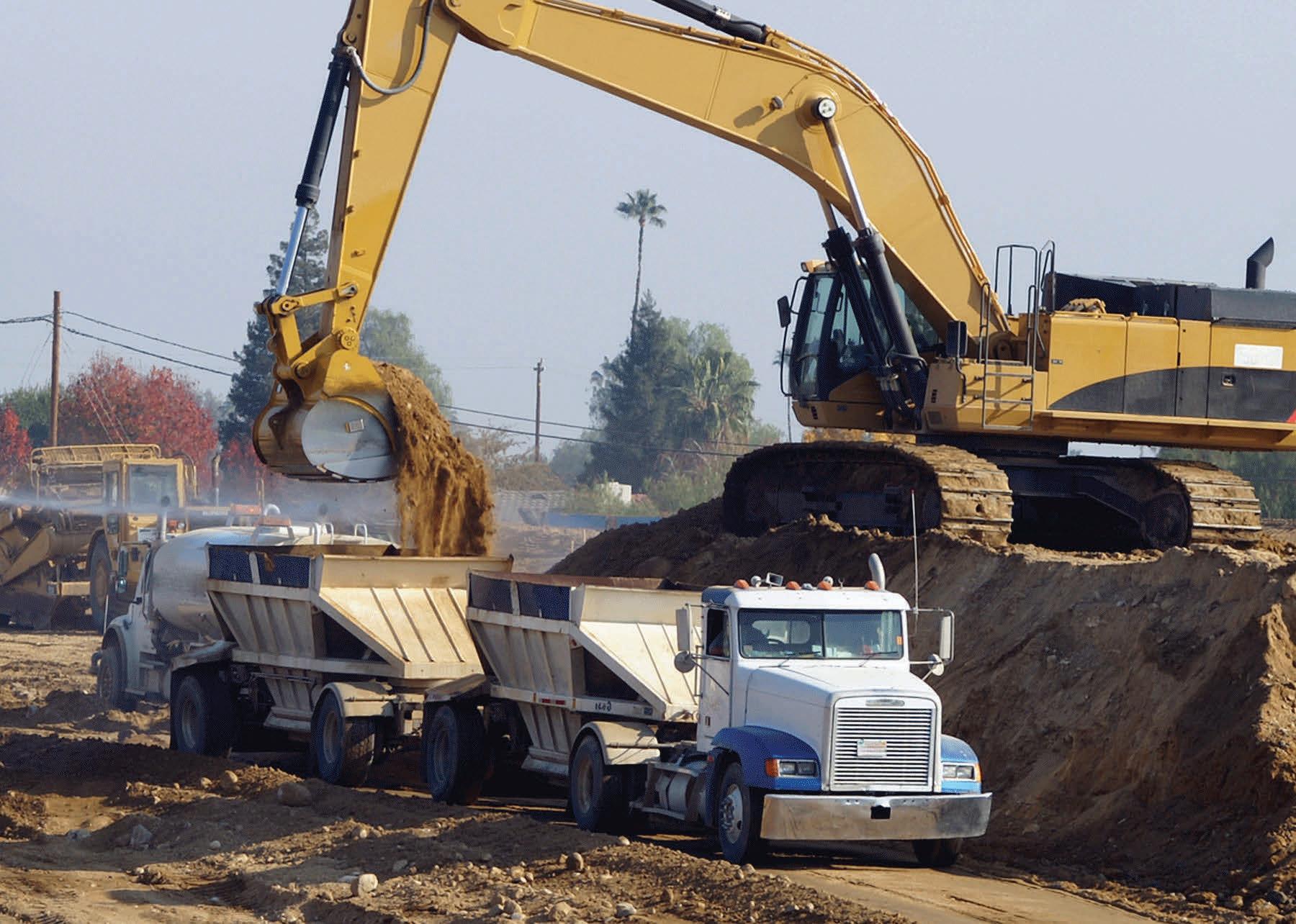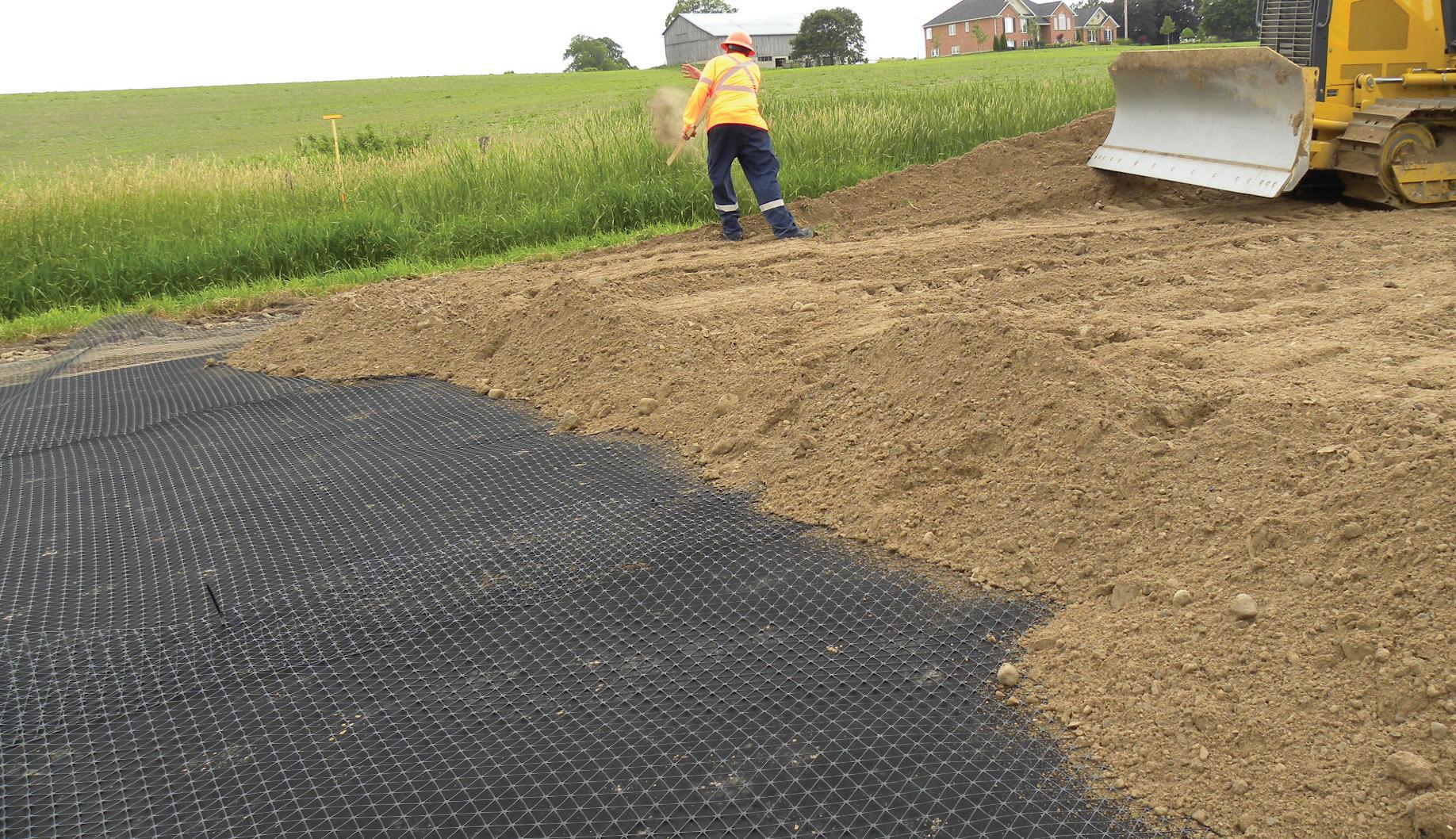

OTTAWA CONFEDERATION LINE IS MAKING TRACKS

Soft Skills are Critical to Company Success
Adopting the Drones



Carillion plc is one of North America’s leading support services and construction companies. We have operations across North America, Britain, Europe, the Middle East, North Africa and the Caribbean.
Our portfolio of award-winning work in areas vital to society includes: road, rail, health, education and regeneration, defence and commercial property. From first concept to ongoing facilities management and support services, we provide high quality, cost effective and sustainable solutions - tailored to the needs of our customers.
Contact us at 905.532.5200
To learn more about Carillion please visit www.carillion.ca
we see your project from a different perspective
Highways Management
Building Construction
Integrated Facilities Management
Infrastructure Development we see the potential that you see















is published quarterly for:
The Ontario Road Builders’ Association
365 Brunel Road, Unit 1 Mississauga, ON L4Z 1Z5 Tel: (905) 507-1107 Fax: (905) 890-8122 www.orba.org
Publisher Robert Thompson
Editor Ali Mintenko-Crane
Sales Manager
John Pashko
Sales Executives
Gary Fustey, Pat Johnston, Walter Niekamp, Jack Smith, David Tetlock
Senior Design Specialist
Krista Zimmermann
Design Specialist
Kelli McCutcheon
Published by:
m ediaedgepublishing.co m
33 South Station Street North York, ON Canada M9N 2B2 Toll Free: (866) 480-4717 robertt@mediaedge.ca 531 Marion Street Winnipeg, MB Canada R2J 0J9 Toll Free: (866) 201-3096 Fax: (204) 480-4420
President Kevin Brown
Senior
Robert Thompson
Branch
EXECUTIVE DIRECTOR’S MESSAGE
The busy road ahead
It is my pleasure to introduce the summer 2015 edition of ORBA’s Road Builder magazine. This issue arrives during a particular busy time for our industry, both from a seasonal perspective as well as the number of projects on the street (pardon the pun).
In this issue, we turn a spotlight on the ideas, projects, and trends driving this growth. We also touch on the partnerships ORBA continues to foster with its many industry stakeholders. Of course, this includes our colleagues at the Ministry of Transportation, whose commitment to issuing early tender calls has allowed our members to begin working earlier in the season. We plan to build on this progress by working with municipalities and regions across the province to help overcome remaining obstacles to early tenders, while laying the foundation for longer-term and mid-year budgets.
On the topic of budgets, please read with interest Ashley De Souza’s report on the 2015 provincial budget. Ontario’s financial game plan includes a number of investments and initiatives aimed at improving the infrastructure environment, and we are eager to follow these developments as they begin rolling out.
ORBA’s staff and committees are also busy contending with a number of other new developments and challenges. These include staying up to speed on Bill 99, the Safer Roads and Safer Communities Act, and following winter maintenance issues such as the new RFP for Kenora. We are also looking at asphalt specifications through our involvement in the MTO’s Asphalt Cement Steering Committee.
Closer to home, I want to thank everyone who helped make our Summer Round-Up at Hamilton’s Sarcoa Restaurant this June a great success.


The evening was well attended and provided everyone with an opportunity to share a drink and conversation with colleagues and key industry stakeholders, including Ontario Transportation Minister Steven Del Duca. Mark your calendars for Saturday October 17, 2015 when we hope to repeat this success during our Ladies Night at the Ritz Carleton Toronto. We’ll be sharing further details on our (soon to be renovated) website closer to the event.
In our last edition of Road Builder magazine we provided a spot light on ORBA’s book, The History of Roads and Road Building in Ontario - Keeping Ontario Moving. Without repeating those details, I will say that this is a very well written account of the history of our industry with some interesting and unique stories told from some of the legends in the industry. More information about the book, and an online order form, are now available on the ORBA website.
Looking ahead to future editions of Road Builder, I encourage you to help us make this magazine an even stronger resource for you and your business by sharing your stories and article suggestions with myself (Geoff@orba.org), Richard Stamper (Richard@orba.org), or ORBA President Blair McArthur (Blair. mcarthur@millergroup.ca). 2015 holds great promise for our industry, and we’re proud to share with you the opportunities, successes, and new ideas that are shaping it on a daily basis.






AROUND QUEEN’S PARK
MPPs break for summer recess
On June 4, Queen’s Park recessed for the summer which sees MPPs return to their ridings to focus on their constituency work, attend local events and local projects. Before the Legislature rose for the summer, which returns on September 14, a number of Bills including the Budget Bill were passed along with a number of advancements on other government policy initiatives. Below is only a snapshot of some of those government initiatives and legislative updates, as well as work ORBA’s government relations team has been undertaking.
2015 Ontario Budget
The Ontario government recently passed Bill 91: Building Ontario Up Act. The Budget Bill had a very heavy focus on transit and transportation infrastructure. Dedicated funds for Moving Ontario Forward, Ontario’s transit and transportation investment plan, are set to increase by $2.6B for a total of $31.5B over 10 years.
The Budget also maintains capital spending levels at Provincial Highways Management at approximately $2.5B which is something ORBA has long advocated for. Additionally, MTO had announced 72 early tender calls in 2015 with an approximate value of $785 million in projects. This is almost double the amount that has traditionally been tendered in previous years.
It was unveiled that real GDP growth for 2015 is forecasted at 2.7 per cent and that the 2014-15 deficit came in at $10.9B. In this Budget, the government of Ontario is projecting a deficit of $8.5B in 2015-16; $4.8B in 2016-17 and a return to balance in 2017-18.
Other issues of interest to ORBA members:
• Forest Access Roads: investing $60 million in 201516 into a Forest Access Roads program to provide better connectivity between product and market
• Experience Ontario: investing $20 million in a new pilot project to support graduating high school students better identify goals and choose the most appropriate post-secondary option

• Increasing investments in pre-apprenticeship programs by $13 million over two years
• Additional funding to the Apprenticeship Enhancement Fund of $23M over two years to colleges and other training delivery agents to train more people
• Auto insurance reform: requiring insurers to offer a discount for the use of winter tires
WSIB
The WSIB has initiated a review of its Employer Classification, Premium Rate Setting and Experience Rating systems. As part of this review, the WSIB has developed a proposed preliminary Rate Framework. The key features of the proposed preliminary Rate Framework review are: simplified classification system; process that sets premium rates, reflecting individual employers’ claims experience relative to their industry; and considerations for a transition path to ensure employers can gradually adjust to the new premium rate setting process.
Construction would go from the current 12 groups into three classes; building construction, infrastructure construction and specialty trades construction. The WSIB has put together a Rate Framework Reform Package consisting of five papers, which can be found on their website. The WSIB consultation on the proposed Rate Framework will include a number of different phases with the first round of stakeholder feedback due October 2, 2015. ORBA’s Occupational Health & Safety (OH&S) Committee is working to put together a submission on the proposed framework.
Bill 6, Infrastructure for Jobs and ProsperityAct,2014
On June 4, the government of Ontario passed Bill 6: Infrastructure for Jobs and Prosperity Act, 2014. The Act encourages strategic long-term infrastructure planning through four key components:
• Long-term planning – requiring the province to table and maintain a 10 year long-term infrastructure plan
• Guiding Principles – maximize the value of infrastructure investments, promote innovation, competitiveness and job creation
• Project prioritization – the province would consider giving priority to infrastructure proposals that align with provincial plans
• Skills training and apprenticeship – the province would employ or engage apprentices in the construction or maintenance of certain provincial infrastructure projects.
ORBA is pleased with the passing of the Act as it would encourage long-term infrastructure planning and economic growth. ORBA worked closely with the government to address issues it had with the initial prescriptive approach and language in the Bill to set a threshold of apprentices to be employed or engaged on construction projects.
ORBA’s belief was that threshold based approaches can create artificial short-term opportunities for apprentices that do not last beyond the project. ORBA had concerns around the establishment, application and enforcement of a threshold model in the construction industry.
Working at Heights
As of April 1, construction workers who use a personal fall protection system will be required to successfully complete a training program that is approved by the Chief Prevention Office and delivered by an approved provider. The new Working at Heights Training Program Standard applies to all construction projects in Ontario and includes: rights and responsibilities related to working at heights, hazard identification, ladder safety, and proper usage of personal protective equipment.
Workers trained under the current fall protection training requirements in the Regulation for Construction Projects before April 1, 2015 will have until April 1, 2017 to also be trained under the new requirements. The Ministry of Labour has approved a number of companies as meeting the Working at Heights Training Program and Provider Standard. The complete list and detailed information of the approved companies can be found on the Ministry of Labour’s website.
Reversing vehicles in work zones project
In June, through the Research Opportunities Program, a project on reversing vehicles led by Laurentian University was awarded $197,472. The priority of the project is line of sight perceptions and reversing technologies to increase situational awareness in the construction industry. The project will research industry wide surveys of attitudes towards interactions between humans and equipment, knowledge of safe work practices for heavy equipment and pedestrian, workers’ compliance with safety behaviour and knowledge of line of sight and safe working distances around heavy equipment
Special recognition and thanks to Nadia Todorova and OH&S Committee member Jim LaFontaine who were heavily involved in putting together the project proposal. ORBA’s Occupational Health and Safety Committee will continue to be involved in the project as more details on implementation become available.
Municipal Infrastructure Deficits
Finally, municipal infrastructure deficits continue to be a top priority for ORBA and our members. Our work in partnering with CAA on the 2015 Worst Roads Campaign helped shine a light on the state of disrepair of our roads across the Province and the need to invest in proper road maintenance.
Municipalities own almost 50 per cent of Ontario’s public infrastructure; more than double the provincial and federal governments combined. The municipal infrastructure deficit for roads and bridges is a staggering $28 billion.
ORBA continues to advocate for commitments from all levels of government to ensure that substantive measures are being taken to eliminate the staggering infrastructure deficit currently facing municipalities in order to place municipalities and Ontario at a competitive advantage.
As always, if you ever need more information or assistance on a specific topic or issue, please do not hesitate to contact me directly at 905-507-1107 ext. 223 or ashley@orba.org . We’re here to help.

TECHNOLOGY
ADOPTING the DRONES
WHAT THE INDUSTRY CAN GAIN FROM UAV TECHNOLOGIES
by MATTHEW BRADFORD

From wearable tech to cloud-based software, there is no shortage of innovative technologies on offer to the construction industry. Among the more promising of these innovations to arrive in recent years is the Unmanned Aerial Vehicle (UAVs, aka Drones), a potentially game-changing tool that is beginning to make its mark on job sites across Canada – yet not without some resistance.
“[Drone] use here in Canada is still in a relatively early stage,” observes Lauren Hasegawa, Co-Founder of Bridgit, a construction technology firm specializing in industry software. “Some construction companies have started testing drone technology on site and experimenting with drone capabilities internally, but we haven’t yet seen widespread adoption of the technology.”
Available in many sizes and specs, the term “drone” applies to unmanned aircrafts that can be operated remotely via ground controls or on-the-fly with onboard

165 Cartwright Avenue, Toronto, Ontario M6A 1V5
Tel: (416) 785-5110 Fax: (416) 785-5120 www.petomaccallum.com
BARRIE, HAMILTON, KITCHENER, TORONTO
computers. And while their military applications have been well documented (if not criticized), drones have more recently gained popularity among aviation hobbyists and a growing number of industries (i.e roofing, farming, law enforcement, journalism, etc.) where models equipped with cameras and wireless data transfer capabilities are bringing a new perspective and functionality to various fields.
Similarly, drones pose a number of benefits to the road building industry. As a surveillance tool, they can also be useful in identifying potential site hazards, making basic repairs, and observing areas that would otherwise be difficult to get to by traditional means.
Outfitted with the right equipment, drones can also offer a faster and more-cost efficient way of surveying a project site. Once in the air, they can traverse large distances in short time and share on-the-fly images with job site planners, who can then map those images back to the project model and use that real-time data to keep tabs on the project’s progress.
“Typically, imaging like that is very expensive and something you wouldn’t be able to do routinely throughout the project. With the growing popularity of drones, however, these kinds of aerial images are becoming far more accessible. Today, being able to fly a drone daily is conceivably something that could be done. That kind of frequency was previously neither practical nor affordable,” says Hasegawa.
Despite these benefits, the adoption of drones on Canadian job sites remains slow. This can be attributed to a number of factors; not the least of which is a general lack of awareness for drone technology and its potential appli-

cations. And while one need only look online or consult the rising number of drone manufacturers in the marketplace for this information, the construction industry still seems reluctant to bring drones into their operations.
“This is such a new technology that people aren’t familiar with best practises and how to use drones on site. So even though they may be very beneficial, correctly deploying drones still requires an expert coming in and being able to handle that on-boarding process,” explains Hasegawa. “It might be that a company is really interested and can see all the benefits that drones offer, but they don’t really know how to start because it’s not really what they do. In those cases, they’d need to bring somebody in who can handle that so they’re not wasting a whole bunch of time and resources to get that project up and running.”
This slow adoption rate is typical for any new technology; especially for equipment as potentially game-changing as drones. That said, the rate of technological advancement often eclipses the rate at which companies and organizations are ready and willing to adopt them, and these days that pace is even more pronounced. Whereas in the past it took 40 years to evolve from the first PC to the first iPad, today’s technological revolutions are occurring at a break-neck speed. And with organizations struggling to keep pace, the technology gap is widening.
“Over the next few years, companies who are not embracing new technology will start to fall behind,” warns Hasegawa. “We’re also seeing lots of different consumer technologies coming out that aren’t necessarily geared towards construction, but still have a huge potential use for the construction industry. Overall, the industry as a whole has a responsibility to take a serious look at all the different emerging technologies and ask, ‘What is it that we’re going to do to stay open minded? What are all these different options coming our way, and how are we going to deal with them?’”
Lofty Legislation
Adoption hurdles notwithstanding, drones are also at the mercy of Transport Canada’s evolving aviation legislations. Under the current rules, for example, using an unmanned aircraft for work or research is subject to certain restrictions. Those operating aircrafts weighing 25kg or more must first obtain a Special Flight Operations Certificate before flying, while aircrafts under that weight may qualify for an exemption. In both cases, the use of drones – be it commercial or personal – must still be reported, and basic flight training requirements and an adherence to standard aviation rules still apply.
The trouble with today’s legislation is that many of the rules are vague and not entirely enforced. Addressing this, Transport Canada announced in May 2015 that it would begin consultations with stakeholders from numerous industries on proposed changes to UAV safety regulations.
In its announcement to the media, the department stated: “Transport Canada is exploring changes to the regulations that will address the growing popularity and economic

Construction technologies were the focus of the Ontario Civil Construction Technology Roadshow. Hosted by Ritchie Bros. Auctioneers on April 23, the one-day event turned a spotlight on the latest construction, survey, civil engineering, architecture and design technologies. ORBA was proud to sponsor the education session during the event. The day also featured many presentations, equipment demos, and technology innovations from industry leaders such as Topcon, John Deere, GeoShack, and Nortrax.
importance of UAVs and integrate them safely into Canadian airspace. The department published a Notice of Proposed Amendment that highlights several proposed changes, including new flight rules, aircraft marking and registration requirements, knowledge testing, minimum age limits, and pilot permits for certain UAV operators.”
Those talks are set to occur over the coming months and include stakeholder collaborations across the country. According to Minister of Transport Lisa Raitt, the goal is to provide clearer guidelines for the use of drones and aid in their safe and responsible use within Canadian businesses.
“Transport Canada is proud to be at the international vanguard of UAV safety. The goal of these new proposed regulations is to support the enjoyment and development of this budding sector while keeping people on the ground and in the sky safe. I look forward to hearing from our stakeholders as I consult them in the coming months,” she stated.
The potential of drones on road and infrastructure construction sites cannot be understated. With more and more industries beginning to see these benefits for themselves, it falls on organizational leaders to take a genuine look at how this technology can bring much-needed innovations and evolutions to the job site and, in doing, enhance Canada’s competitiveness on a global scale.
After all, warns Hasegawa: “Adapting to new technologies like these is a slow and gradual change, but if we push that change off any longer it’s only going to be harder, because there will be that much more of a gap to cover two years from now than there is now.”
EDUCATION & TRAINING
SOFT SKILLS ARE CRITICAL TO COMPANY SUCCESS
AND THE RETURN ON INVESTMENT IS HUGE
Industry training used to focus exclusively on technical skills. Today, a greater appreciation is given to the so-called “soft skills” of leadership and customer service.
Pat DeMers, owner of Excel Thru Learning, says it’s not unusual for companies to contact her after realizing they already have a problem.
“Companies don’t tend to think soft skills are important until they start losing people. Employees will work very hard for the right managers and do very little for the wrong ones,” she says. “Leadership skills are critical to a company’s success. Without good leaders, employees can’t be good followers. And if they aren’t good followers, they can’t be good employees.”
Skilled workers are in demand, and they won’t stay at a job where they’re not happy. DeMers says the days of starting at a company when you’re 19 or 20 years old and expecting to retire there are over.
“There’s an attitude of, ‘If I don’t like my manager, I don’t care because there’s a lot of work out there.’ If you have inappropriate behaviours
“People lose customers through a lack of social ability and a lack of respect.”
– Pat DeMers
at your workplace like screaming and swearing, people aren’t going to stay,” she explains. “And since we have the most educated workforce (in history), they won’t stay.”
While many people still believe leaders are born, not made, DeMers insists that leadership is a learned skill. She says that everyone can benefit from leadership training.
“It’s a different way of thinking. You don’t want to hire for today. You want to hire for tomorrow—where could this person go? Two thirds of what we teach is leadership at some level. There are some things all leaders have to know,” DeMers says.
An old-fashioned style of leadership, where managers issue direct orders and employees are expected to comply, is no longer effective in today’s workplace.
“Managers and team members should work together in collaboration,” says DeMers. “It’s a totally different conversation. It’s not the boss saying to the employee, ‘Go do it,’ anymore. When I want to do something, I’m going to do it. If I’m told to do something, I may or may not do it. If I have a habit of being bossy, I have to learn that it’s not going to work for me.”
She says managers can be taught how to have these conversations with their employees without losing productivity.
Leadership training is crucial in the road-building industry as more and more senior managers retire.
“We have an aging population. Very young people have to take over man-
by HOLLI MONCRIEFF
aging others and they’re not ready. They’re going to have to take over the leadership role and lead even younger generations,” DeMers says. “They’re doing the best they can, but in most situations, they’re doing it wrong. These young people are looking to be mentored and coached. You’ve got to respect them and you have to lead them.”
Customer service is another critical skill for every business, especially with the prevalence of social media. If one of your employees is rude to the public, the likelihood that everyone will hear about it on Facebook and Twitter is high, says DeMers.
“Some people don’t think customer service relates to our industry, but it has tons to do with our industry. Contracts are won through relationships that have been built and through a company’s reputation. You can get customers just by doing the right thing,” she says. “People lose customers through a lack of social ability and a lack of respect.”
Training in customer service helps bring a level of professionalism to the industry that is not only appreciated, but also expected.
“Things that used to be socially acceptable aren’t anymore. The environment is changing. We’re going to see more women get into these businesses, and that will change things too,” says DeMers. “If workers whistle or catcall, they can lose their jobs or be sued. There is a level of professionalism that’s expected now.”
Customer-service training dovetails nicely with the mandatory legislative
training in Ontario, which includes health and safety, Bill 168 (bullying and harassment), and the Accessibility for Ontarians with Disabilities Act
“The impact of this can be huge, especially with things like social media. Soft skills are a very smart place for people to spend their money because there’s a huge return on investment,
even though it’s difficult to measure,” says DeMers. “Every time you lose someone, it takes six months to a year for a new employee to get up to speed.”
DeMers recommends customized training for the highest impact.
Mentoring and one-on-one coaching are also great alternatives, she says.
“The trend is to customize training to what each business needs. Businesses aren’t sending people to open courses anymore, because the return on investment is very low,” DeMers says. “A customized approach is the best approach—one shoe doesn’t fit all when it comes to training and training isn’t the only answer.
2015 ORBA SCHOLARSHIP RECIPIENTS PASSIONATE TO CONTRIBUTE


Ontario Road Builders’ Association congratulates this year’s recipients of the Civil Engineering and Civil Engineering Technology Scholarships.
Claudius Dalm, entering his first year this September in the Bachelor of Applied Science Engineering program at Windsor University, was awarded the $2,000 Civil Engineering Scholarship.

James Thompson, entering his first year at St. Clair College this fall enrolled in the Civil Engineering Technology program, was awarded the $2,000 Civil Engineering Technology Scholarship.
Claudius and James will be recognized for their achievements by the industry at ORBA’s 2016 Convention in Toronto on February 1, 2016.


Claudius Dalm James Thompson
FEATURE
OTTAWA CONFEDERATION LINE is MAKING TRACKS
by MATTHEW BRADFORD

THIS
ARTICLE IS THE FIRST OF A NEW SERIES PROFILING ONTARIO’S KEY TRANSPORTATION INFRASTRUCTURE PROJECTS.
One of the largest transportation projects in Ottawa’s history is currently taking shape on and under the capitol city’s streets. Launched in spring 2013, the Ottawa Confederation Line is a $2.1 billion project that will see the replacement of the city’s Bus Rapid Transit (BRT) system with a new Light Rail Transit (LRT) system connecting critical transit services across a 12.5 kilometre route.
The OC Transpo initiative is the first project of its kind in Ottawa to be delivered as a P3 scheme. Once completed in spring 2018, it will link LRT riders from the city’s western Tunney’s Pasture Station to its eastern Blair Road Station and include 13 stations along its path. Three of those will be developed along the line’s 2.5 km underground tunnel – one of the largest of its kind in the city’s history.
“This is a hugely important project for everyone,” says Steve Cripps, Director of Ottawa’s Rail Implementation Office, and former Executive Director and Chief Engineer with the Ministry of Transportation. “Ottawa has a Bus Rapid Transit system which works very well for the most part, but as the east-west busses come into the downtown core, they’re no longer on a dedicated transit-way, so they tend to create a bottleneck and the system breaks down.”
“This new system will virtually eliminate that bottleneck, allowing commuters to travel from one end of the route to the other in 24 minutes, as opposed to the current 10 to 15 minutes it takes commuters to traverse the downtown core alone,” he adds.
The ambitious Design Build contract is being carried out in three core segments by private-sector project consortium Rideau Transit Group, which consists of Dragados Canada Inc., EllisDon, SNC-Lavalin, and ACS Infrastructure Canada. At time of print, the team has concluded approximately 60 per cent of the tunnel excavation, and is slated to reach substantial completion of the line’s maintenance and storage facility by August.
Reflecting on RTG’s progress to date and the phases ahead, Daniel Botero, Senior Vice President of Operations with Dragados, notes, “We’re building a very, very complex transit system that requires us to integrate many different types of systems for communications, train control, and manage all the civil works. It is an interesting challenge, but Dragados is fortunate to have over 1,300 kilometres of tunneling experience throughout the world and to be working with a team of equally experienced partners.”
Planning Ahead
Given the project’s scope, it’s no surprise Ottawa made project planning and management a priority. Golder Associates Ltd. played a significant role in that planning back in 2009 when it joined the city as its geotechnical consultant to carry out geotechnical, hydro, geological, archeological, and environmental investigations along the entirety of the proposed route.
According to William Cavers, Associate and Geotechnical Engineer with the firm, it was evident from the beginning that the city was committed to starting the line’s develop-

ment on the right foot. “The preliminary engineering for a Design Build project is a little different than a typical Design Bid Build project because you only take it to 30 per cent design. However, in the case of environmental, geotechnical, archeological investigations, you really want to get those closer to 90 per cent because that’s the information the bidders really need to understand the risks involved in the project and to price it accordingly. And that’s what the city asked us to do.”
Golder Associates was tasked with drilling 256 bore holes through the core of the main city during its investigation on the city’s behalf to provide as much information as possible to its prospective bidders and, in the process, reduce future costs. It was no small task, says Cavers, but solid project management and teamwork saw the team through: “It can be a real challenge trying to carry out an investigation in such a dense, urban environment while managing the concerns of all the stakeholders, but the city did an excellent job managing everyone. It was very much a team-focused approach.”
In another forward-thinking move, Ottawa bundled its Confederation Line contract with the expansion of the city’s Highway 417 to provide routes for BRT vehicles while their dedicated lanes underwent the LRT conversion.
“One of the huge challenges with converting from a BRT to a LRT system is you have to continue running a service the city is used to and expects, while not having those
dedicated rights of way,” explains Cripps, adding, “If those buses weren’t on the highway now, they’d be on regular arterial roads and that much extra construction would create a negative public perception. We’ve been able to alleviate that by adding those extra lanes on the highway.”
Digging Deep
One of the most daunting challenges of the entire Confederation Line build is the construction of a 2.5 km underground tunnel beneath Ottawa’s downtown core.
“Certainly, tunneling right through the core of Ottawa has its challenges. The foundations are incredibly close to the tunnels, so that requires a lot of care and a lot of stakeholders relations,” says Cripps. “We’re constantly having to work and communicate with the folks downtown, and monitor for noise and vibration to make sure the contractors are meeting requirements.”
To minimize disruptions, crews employed a sequential excavation method (SEM), which uses road headers equipped with cutting heads to grind the rock as they push forward, as opposed to using traditional cut-andcover boring techniques.
“It’s a fairly unique approach to tunneling because it gives the contractor the flexibility to attack the tunnel at different locations and undertake different approaches and sequences to minimize noise and vibration for adjacent buildings,” explains Cripps.


HAMILTON’S LRT INVESTMENT
Ottawa’s Confederation Line is one of multiple LRT projects in development with Ontario. Another includes Hamilton’s own light-rail transit initiative, which received a $1.2 billion commitment from Premier Kathleen Wynne this spring.
“Our investment in the Hamilton LRT will help support the exciting revitalization underway in Hamilton,” Wynne announced. “We are making record investments across Ontario in infrastructure projects like this to strengthen our economy and quality of life — and lay the groundwork for future prosperity.”

The 11 kilometre east-west LRT line will run from McMaster University to Hamilton’s Queenston traffic circle. It will pass through the city’s central business district and also connect to the West Harbour Go Station, which is currently under construction.
Procurement for the LRT will start in 2017. Construction will then begin in 2019 and work towards a 2024 opening.
“We are committed to investing in transit projects and to building necessary infrastructure for our province now and for the future,” said Steven Del Duca, Minister of Transportation. “With LRT on the way, people in Hamilton can look forward to a new way to travel. This is further proof of our government’s commitment to making the daily commute and quality of life better for Ontario families.”
Challenging though it may be, the importance of the underground tunnel is not lost on RTG’s team. Says Botero, “Prior to this line, the congestion of the BRT system through downtown Ottawa was quite disruptive for the city. Having all the transit operating underground is going to substantially ease the traffic around downtown Ottawa.”
Making Tracks
Thanks to the city’s support and RTG’s combined talents, the team has made considerable progress on this initial stage of the Confederation Line’s construction. This year will also mark the beginning of the next phase of Confederation Line work, which includes station, track, and vehicle construction. Moving forward, the Confederation Line will also serve as a launching point for future OC Transpo initiatives.
“We’re building the first brick in a massive building, so in that sense I believe it is quite important for the city of Ottawa,” says Botero.
Looking both ahead and below, Cavers adds, “A lot of people don’t realize what’s going on beneath their feet, but I do and it gives me quite a bit of quiet pride.”
For more information on the Ottawa Confederation Line, and to keep track of its progress, visit www.ligneconfederationline.ca.




SITECH Mid-Canada Ltd. is Your Local Trimble Construction Technology Provider
SITECH Mid-Canada Ltd. offers the most comprehensive range of Trimble Construction Technology products in the marketplace. SITECH will provide you with an integrated system of Trimble products that will grow with your business. Finally, a total solution that can be configured for your needs.

www.SitechMidCanada.com
The Complete Package
Trimble Construction Technology will change the way work is done. Increase productivity at a higher level of accuracy and cut costs without risking quality. Visit SITECH Mid-Canada Ltd. for a comprehensive analysis of your workflow and increase your efficiency today.
The PUSH for BILL 99
CALLING FOR LESS HAZARDOUS CONDITIONS FOR ROAD WORKERS AND THE PUBLIC ALIKE
by RICHARD WOODBURY
As the MPP who introduced Bill 99, the Safer Roads and Safer Communities Act, there’s a good reason why Taras Natyshak brings a lot of depth and understanding to why the bill is needed. Prior to being elected to office, Natyshak worked in the heavy construction sector for 10 years as a general labourer. Part of his duties included setting up traffic control systems on the province’s 400 series of highways, so he understands the risks those working in the road building industry face as they carry out their work. If passed, the bill will require the use of safety cameras in construction zones and community safety zones.
Road construction workers face a range of hazards on the job, including the weather, which can cause things like heat stress and cold stress. As well, people often have to work at heights and there is the risk of injury
“Our industry is all about safety. It’s obviously the number one priority…”
– David Carroll

from the physical nature of the work itself and being struck by a vehicle.
According to a July 2, 2014 article in the St. Thomas Times Journal, between 1997 and 2011, 138 road workers were killed because of collisions at highway and road maintenance sites in Ontario, an average of just over nine deaths per year.*
Even when a vehicle passes by and no contact is made – a near miss – it can leave both a physical and psychological impact. “When a heavy transport truck comes through at a high rate of speed, it’s enough to knock you off your feet,” says Natyshak. “I recall even my hard hat getting blown off.” As well, “you’re more hesitant to put your neck out there, so to speak,” he says.
By allowing for safety cameras to be used in construction zones and community safety zones, it would act as a deterrent to speed through these zones. Community safety zones are found in school zones, near parks, playgrounds and seniors’ residences. In other words, Bill 99 would provide additional protection for road construction workers, children and seniors. “We must do absolutely everything we can to ensure they are all safe,” says Natyshak.
With safety cameras in place, people speeding through construction zones and community safety zones would
be fined. It is Natyshak’s hope no money would ever be collected from the measure. He just hopes people would alter their driving behaviour. From his standpoint, this isn’t a cash grab. “This is not that,” says Natyshak. “These are specifically-prescribed areas identifying populations of people that may be more vulnerable when interacting with live traffic. What we’re looking to do is simply give the ability to identify and enhance enforcement in them with the use of safety cameras and further protect those citizens.”
The first reading of Bill 99 was carried on May 11, 2015. To date, the bill has been endorsed by a variety of organizations: ORBA, Insurance Bureau of Canada, the Ontario Safety League, Ontario Good Roads Association, and the Ontario School Bus Association.
David Carroll is the safety and legislation consultant with the Ontario School Bus Association (OSBA), a non-profit association representing school bus fleets, school and transportation consortia, and supplier and manufacturing companies. “Our industry is all about safety. It’s obviously the number one priority. Getting traffic to comply with speed limits in safety-sensitive areas like construction zones and school zones just makes a lot of sense,” says Carroll.
The Push for Bill 99
As well, Bill 99 could also have a broader societal impact. “It would free up a lot of police resources to do other important work and at the same time to act as a deterrent to those who may be pre-disposed to break the law. We think it would be a good use of resources,” says Carroll.
Sue Gardonio is the chair of ORBA’s Occupational Health and Safety Committee. She also co-owns Facca, a heavy civil construction firm, and is Natyshak’s sister. Gardonio says that despite measures such as speed bumps in community safety zones, it hasn’t led drivers to change the way they drive, so it’s time to try something different. She sees Bill 99 as being a proactive measure, a way of preventing accidents from happening and ensuring that workers in the road construction industry and vulnerable populations are better protected in community safety zones. “We’re all trying to send our workers home at night safe and we’re asking for the driving public to help us in that and be a partner with us in keeping our workers safe, keeping our children and keeping our elderly from being hurt,” she says.
Gardonio says that while people may think an accident involving a worker in the road construction industry only touches a certain subset of the population, it in fact has a broader impact on the community. “If a worker gets killed or if there is some sort of devastating accident, the community is involved because that is a parent of somebody, that’s a father, that’s a grandfather. You can’t take that community aspect out of it,” she says.
Natyshak is an NDP MPP, so he’s not part of the Liberal government in power, but he’s optimistic the bill will eventually pass. The bill itself is essentially a re-introduction of a bill tabled by former Liberal MPP and cabinet minister David Caplan in 2010, but the bill didn’t become law. This time around, the words “photoradar system” are being swapped out for “safety camera.”
Photo radar has long been a contentious issue in Ontario. “Former
NDP premier Bob Rae launched photo radar on Ontario highways in August 1994 and it was scrapped by his Progressive Conservative successor Mike Harris just 11 months later after being a key issue in the 1995 election,” says a Nov. 16, 2010 Toronto Star article.**
The experience from other jurisdictions which have used safety cameras has shown they have reduced speeding and accidents in the areas in which they were installed. According to a 2005 British Medical Journal report
that reviewed scientific studies relating to the effectiveness of safety cameras, while different levels of reductions were recorded, the bottom line is there were decreases in the numbers of collisions, injuries and deaths. The report examined studies looking at data from Norway, the U.K., New Zealand and British Columbia.
* http://www.stthomastimesjournal.com/ 2014/07/02/worker-killed-on-hwy-3
** http://www.thestar.com/news/canada/ 2010/11/16/use_photo_radar_at_schools_and_ construction_sites_mpp.html

MUNICIPAL
A PROACTIVE APPROACH
TO ORBA’S MUNICIPAL STRATEGY
by RICHARD WOODBURY
Elections are a time for optimism and it is also when the desire to do things more effectively is strong. During last fall’s municipal elections, it was the perfect time for ORBA to launch a municipal advocacy program. “It really provided a perfect opportunity for ORBA to introduce itself to the newly and the re-elected mayors and regional chairs,” says Nadia Todorova, ORBA’s policy analyst. At the same time, ORBA began meeting with municipal staff to discuss more technical issues, as well as policies and procedures.
The motivation behind these actions is ORBA’s municipal strategy, which has defined forging closer relationships with municipalities as a priority, especially given many of ORBA’s members do work for municipalities in Ontario. ORBA recently began offering a municipal membership category to allow municipal contractors to be members of the association.
There are a number of issues ORBA has been discussing with municipal officials, including the municipal infrastructure deficit, which is currently pegged at over $60 billion on Ontario, of which $28 billion is the infrastructure gap for roads and bridges alone. ORBA’s position is that consistent and reliable infrastructure funding drives Ontario’s economy, contributes to Ontario’s wealth and productivity, and attracts investment and jobs. “An efficient transit and transportation system is essential for a vibrant economy and good quality of life – connecting our communities and enabling businesses to get their goods to market,” said Geoff Wilkinson, ORBA’s executive director in a June 2015 press release.
Another one of ORBA’s concerns is that municipalities have different specifications and different policies. Todorova would like to see a streamlining of processes and more consistent policies across the province.
One of the side effects of not having uniform specifications is it results in differences in road quality across the province. This was especially evident during the feedback garnered from people during CAA’s Worst Roads campaign. As it stands now, Ontario’s Ministry of Transportation (MTO) develops the specifications and then municipalities tweak them to their own preferences.
Speaking of MTO, the ministry’s recent decision to remove its exclusion clause for legal proceedings on all MTO projects was a welcome change by ORBA and its members that can be used as a template for Ontario municipalities.
ORBA is also working with MTO to improve the dispute-resolution processes related to procurement.
“We think we can provide a good framework on how to deal with procurement issues,” says Todorova, noting ORBA’s existing work on through the CFAAST implementation committee.
Other issues ORBA is working on include open tendering, excess soil, recycles aggregates and utility locates. “We really just want to get more municipalities on board and forge those relationships with them and provide added value for our members,” says Todorova.

WORST ROADS CAMPAIGN
In late May, the Canadian Automobile Association (CAA) released a list of the Top 10 Worst Roads in Ontario. It’s the kind of list there is no pride in being on.
The 10 worst roads were whittled down from a list of 2,000 nominations that came from CAA’s Worst Roads campaign. Three of the top 10 were found in Timmins, with Algonquin Boulevard West and Algonquin Boulevard East occupying the top two spots, respectively.
As technical experts, 15 ORBA member companies inspected 50 shortlisted roads from 10 different regions in Ontario.
The inspections revealed potholes, pavement cracks, rutting and poor traffic flow, and reinforced the need for road maintenance investment.
“Although much work has been done across the province to maintain and repair Ontario’s roads, much more is needed to tackle the staggering municipal infrastructure deficit in Ontario,” said ORBA executive director Geoff Wilkinson, in a news release. “Eliminating the staggering infrastructure deficit currently facing municipalities, as well as expanding our existing transportation infrastructure, will place municipalities and Ontario at a competitive advantage.”
For more information about the Worst Roads Campaign, visit orba.org.

IN YOUR WORLD, BUILD RELIES ON EFFICIENCY
In the world of construction, there are many challenges. You have to balance the costs of machines, fuel and maintenance. And of course, you want to make the most out of your business investment. As your ally for equipment efficiency, we can help with that!
Shell Diesel Extra is especially designed to help save fuel by up to 3%1, reduce maintenance costs and increase the operating hours of your machines. Find out about the potential savings and further benefits of Shell Diesel Extra at www.shell.ca/commercialfuels
Shell Diesel Extra is now available from Bluewave Energy, www.bluewaveenergy.ca
Fuel economy claim tested by
BUSINESS MANAGEMENT
The IMPORTANCE of DIRECTOR and OFFICER LIABILITY INSURANCE
HOW TO PROTECT YOUR CONSTRUCTION COMPANY
Construction is an industry where companies and their management face significant risk exposure due to the nature of the work that is carried out. Directors and officers of construction companies may be subject to liability that results in them facing criminal charges, significant fines or civil lawsuits. Litigation can go on for years and result in substantial legal costs being incurred before resolution. While a corporation may indemnify a director or officer in most situations, there may be situations where indemnification is unavailable. Further, if the director or officer is also the owner of the company, the owner is going to end up paying the cost of indemnification indirectly out of his or her pocket.
The following is a discussion of some of the key sources of liability that directors and officers of private construction companies may face. Aon recommends that directors and officers give careful consideration to their risk management strategy to ensure that risks are appropriately analyzed, mitigated and transferred, which may include the use of Director and Officer (D&O) Liability insurance.
Liability for Compliance with Workplace Health and Safety Requirements
In addition to obligations under provincial health and safety legislation, Section 217.1 of the Criminal Code of Canada (the “Code”) creates a potential criminal liability for every organization or individual in Canada directing or overseeing work being carried out by employees. Under the Code, organizations and individuals have a legal duty when “directing the work of others” to take reasonable steps to ensure the safety of workers and the public. This obligation has been interpreted broadly by the courts. Since its enactment in 2004, there have been a number of cases where charges have been laid against individuals within an organization for violation of Section 217.1 of the Code, including directors and officers who

by JENNIFER DRAKE
were not directly overseeing the task being performed when a worker was injured.
Liability under the Ontario Construction Lien Act
Under Section 13 of the Ontario Construction Lien Act (the “Act”), directors and officers of a corporation may be held liable where they are found to have directed, assented or acquiesced to conduct they knew, or ought reasonably to have known, would amount to a breach of trust by the corporation. In the case of a private construction company, a director or officer might be held personally liable for a breach of trust under the Act where the company receives funds that are to be paid to a subcontractor, or other persons who have supplied materials or services for a project, and those funds are not distributed properly or are used for other purposes.
Liability
for Civil Fines
A number of provincial statutes across Canada contain provisions which permit the imposition of liability upon directors or officers of a corporation for the payment of fines where a corporation’s actions result in a statutory violation. Many of these statutes do not require a director or officer to go so far as to direct the corporate actions which result in a violation of the legislation for liability to attach. In many cases, a director or officer may still face a fine if their actions are found to constitute acquiescence to activities by the corporation that violate a statute.
Liability for
Government Remittances
If a corporation goes bankrupt and fails to remit taxes or GST, the directors of the corporation may be liable to pay the outstanding taxes. Under federal and most provincial tax acts, where a corporation fails to remit taxes that it collected from others, such as deductions from employees’ wages and GST collected from customers, directors will be liable along with the corporation to pay any amount
owing, including interest and penalties, in the event the corporation is insolvent or cannot pay a certificate registered in Federal Court. Directors might be held liable for up to two years after they cease to be director of the company.
Similarly, liability for directors and officers might arise under pension and employment legislation if the company fails to collect and remit pension and employment insurance premiums.
Liability for Unpaid Wages
The federal and provincial business corporation’s statutes hold directors jointly and severally liable for unpaid wages of the company’s employees in the event the company does not pay. Under these provisions, employees may seek reimbursement from the directors of their corporate employer for up to six months of unpaid wages where a judgment against the corporation is not sufficient to cover the amount owing, the corporation has made an assignment in bankruptcy, or the corporation has commenced dissolution proceedings. While there are certain limitations placed on the liability of directors for employee debts, if a corporation is unable to meet its payment obligations to its employees this can result in an enormous liability for its directors.
Liability for Employment Claims
It is not uncommon for employees to make a claim alleging wrongful acts in the workplace, such as wrongful termination, harassment or discrimination. Directors and officers may face liability where they are named as defendants in one of these types of actions. In smaller companies, the company’s key personnel are more likely to be named in litigation brought by employees. For directors and officers, liability may arise where an employee makes allegations that they were negligent in their supervision of employees and allowed a wrongful act to take place,
Directors’ and Officers’ Liability Insurance
D&O insurance can be a valuable risk transfer tool when a director or officer faces a written demand for monetary payment or non-monetary relief, criminal proceedings, civil proceedings, administrative or regulatory proceedings. The insurance can help to lessen the burden that the cost of legal defence expenses, judgments, settlements and civil fines and penalties (where insurable under the law) could place on an individual or the corporation responsible for indemnification. Further, if indemnification is not available to directors and officers, D&O Liability insurance can protect them from having to pay their legal expenses and other loss out of their own pocket.
D&O policies can also provide coverage for the corporation for amounts paid to its directors and officers as a result of its indemnification obligations. This coverage is especially important for the owner of a company that is also a director or officer, as it will allow the owner to recoup the costs of the company where money is spent to indemnify him/her for actions undertaken in his/her capacity as a director or officer.

MEMBER CORNER
ORBA WELCOMES NEW MEMBERS
Contractor Member

Dig-Con International
Established in 1982, Dig-Con International has extensive experience in a wide range of construction services including municipal road construction, sewer and watermain work, asphalt, sidewalk, concrete, bridge and paving work and building design. Through the completion of these various projects, built on reliability and solid performance, Dig-Con has developed a vast customer, supplier and sub-contractor network.
Sam DiGregorio 905-951-1616 dig-con.com

OHL Construction Canada Inc.
Since its establishment in 1911, OHL has grown to lead projects around the globe across varied industry sectors from tunneling and mining to hospitals, airports, highways and railways. OHL works all over the world on some of the most significant and landmark projects ever constructed.
John Krasko, Executive VP Carles Gispert, Executive VP 647-260-4880 www.ohlcanada.com
Municipal Contractor Member

Crupi & Sons Limited
D. Crupi & Sons Limited is a family owned business dating back to its inception in 1951. They operate three asphalt plants across the Toronto Area fulfilling paving and road construction needs of municipalities, developers, and industrial commercial customers. Their expertise in addition to paving includes excavation, granular supply and placing, grinding and snow removal.
Dominic Crupi 416-291-1986 crupigroup.com

Vertical Horizons Contracting Inc.
Vertical Horizons Contracting Inc. is a private commercial/public road works contracting company. They specialize in infrared asphalt heating, road/parking lot maintenance, manhole/CB repair, culvert repair, snow and ice management. Their hands on approach gives VHC a strong emphasis on safety, integrity, reliability and quality.
Joshua Fawcett 416-402-6473 Verticalhorizons.ca
Associate Member

Masters Insurance Limited
Masters Insurance is proud of supporting the Insurance and Surety needs of the Construction Industry for 50 years.
Michael Ciccolini 905-738-4164
mastersinsurance.com

McDougall Energy Inc.
McDougall Energy is a family owned business which has been serving energy customers for over 70 years. Their award winning company is a marketer and distributor of heating oil, propane, gasoline, diesel fuel and Mobil lubricants, as well as an Esso retailer.
Bernie DeOre 905-676-9179
mcdougallcorp.com
Smart. Choice.
Smart. Choice.



ROADS


With lower maintenance budgets and increasing material costs, road builders are under escalating pressure to deliver improved performance for less money. For 38 years, Nilex’s engineered, technically advanced geosynthetic materials have provided customers with smart choices and alternatives to conventional construction practices for paved, unpaved and heavy haul surfaces.
With lower maintenance budgets and increasing material costs, road builders are under escalating pressure to deliver improved performance for less money. For 38 years, Nilex’s engineered, technically advanced geosynthetic materials have provided customers with smart choices and alternatives to conventional construction practices for paved, unpaved and heavy haul surfaces.
Nilex’s geosynthetic solutions offer superior performance for:
Nilex’s geosynthetic solutions offer superior performance for:
• Base reinforcement and pavement optimization
• Base reinforcement and pavement optimization
• Subgrade stabilization
• Subgrade stabilization
• Crack mitigation
• Crack mitigation
• Roadway drainage
• Roadway drainage
• Mechanically Stabilized Earth (MSE) walls
• Mechanically Stabilized Earth (MSE) walls
Innovative, strategic solutions that can reduce aggregate base thickness, save on total project costs and reduce carbon emissions.
Innovative, strategic solutions that can reduce aggregate base thickness, save on total project costs and reduce carbon emissions.
Nilex. Smart. Choice.
Nilex. Smart. Choice.

LABOUR
AMENDING BILL 6
ORBA STRENGTHENS THE APPROACH TO APPRENTICESHIPS
In spring 2014, the Government of Ontario introduced Bill 6, Infrastructure for Jobs and Prosperity Act, 2014, with the intent to spur infrastructural renewal and economic growth through long-term industry planning. The Bill was passed one year later on June 7, 2015, but not before undergoing key amendments to its language surrounding industry apprenticeships, following consultations with ORBA and its members.
The Bill, which received first reading on July 7, 2014, brought forth multiple strategies for sustainable infrastructure planning. These included:
• Long-term planning: The creation and maintenance of a 10-year infrastructure plan.
• Guiding principles: The establishment of guiding principles designed to promote innovation, industry competitiveness, job creation, and infrastructure investments.
• Project prioritization: Consideration to give priority to infrastructure proposals that align with provincial plans.
• Skills training and apprenticeship: A promise to encourage and support apprentices in the construction or maintenance of certain provincial infrastructure projects.
While the spirit of the bill was well received by ORBA and its membership, at issue was its initial language surrounding the use of jobsite apprentices. Specifically, the original draft outlined a plan to set a threshold of apprenticeships on construction projects, whereas

by MATTHEW BRADFORD
ORBA believed these positions –under this language – would create short-term and non-sustainable apprenticeship opportunities.
In its responses publication, Submission to the Standing Committee on General Government regarding Bill 6, sent May 2015, ORBA restated its support for skills training, but expressed concern over the Bill’s prescriptive approach to setting apprenticeship thresholds.
“Establishing and applying thresholds would be incredibly complex for each project due to the complexity of each sector of the construction industry and the subsequent procurement models that are utilized by public sector owners,” read ORBA’s submission. “Additionally, the ability to apply these thresholds, as currently drafted in legislation, to the smaller sub-contractors would be fraught with additional problems.”
As such, ORBA suggested the specific language under Section 8 (2) be replaced with a less prescriptive and more general verbiage concerning apprenticeships. The idea behind the ratification was to help contractors of all sizes and circumstances have greater authority in their apprenticeship initiatives based on their unique circumstances.
“We really advocated for language that allows contractors to be responsible with apprenticeships,” notes Geoff Wilkinson, ORBA’s Executive Director, noting, “We understand the importance of apprenticeships and our industry is committed to apprenticeship training, but we needed to get the point out there that we are
unique. We represent small companies and large companies, so we have to ensure that apprenticeships can be something that all our contractors can work with.”
Through consultations with the Ministry of Economic Development, Employment, and Infrastructure, ORBA was successful in amending Section (8)2. As a result, the language now reads:
Commitment re intended use of apprentices (2) A bidder that enters into a procurement process for the construction or maintenance by the Government of an infrastructure asset shall, in the prescribed circumstances, provide to the Government as part of the procurement process a commitment respecting the intended use of apprentices in the construction or maintenance in the event of a successful bid.
Speaking to ORBA’s influence on the Bill’s final form, Wilkinson says, “With this new language, it’s clear our message has been understood by Infrastructure Ontario and that the government understands some of the challenges that our industry faces with regards to apprenticeships. We’ve seen changes with regards to the language, which now seems very favorable to our industry.”
The Apprenticeship Value
Creating fair and equitable conditions for industry apprenticeships has been an ongoing mission for all industry stakeholders, ORBA included.
Martin Gran, Chief Financial Officer with Pioneer Construction, is one of
many industry leaders who deals first hand with apprenticeships. Challenged by a need to bring talent to the north, he has helped ORBA lobby for changes to apprenticeship rules and believes the restrictive language and legislative roadblocks are counter-productive.
“We’re trying to get people into our industry. It’s hard everywhere, and it’s especially hard in the north where populations are limited and projects tend to be smaller, so anything that you do to make it harder for us to get new employees into the field is just going to exacerbate the problem,” he says.
With an infrastructure boom on the horizon due to industry backlog, Gran adds companies like his are trying to get new people into the industry to meet the projected demand, but notes, “Anything that throws up a barrier will cause people to go elsewhere, and I can’t blame them.”
That’s why many in his position have backed initiatives aimed at bringing new talent to the industry from all corners of the country. Explains Gran: “The industry has broadly supported the Ontario Construction Careers Alliance (OCCA), which is working to educate and attract youth and underrepresented groups to the construction industry. Our feedback through the OCCA is that anything that complicates entry into the industry will only work against us.”
No doubt, finding, implementing, and retaining apprentices can indeed be a logistical issue for road builders; especially for those hoping to lure talent out of big city jurisdictions. Therefore, imposing apprenticeship thresholds that do not take into consideration the unique conditions and sizes of various projects only serves to widen the gap, regardless of their intentions.
“We believe in the theory behind apprenticeships and we all believe in safety; it’s our number one focus. We realize you can’t throw someone off the street onto a machine, and that you have to make sure they’re properly supervised and that’s why
practical training and supervision is important. That’s the right way to train people,” agrees Gran, “However, when you make higher ratios mandatory, you have job sites where you do such tiny volumes with small crews that you can’t take a crew of five people and add two more people and expect it to be economical. It might work in larger centres, or on larger projects, but it doesn’t work in the really small centres.”
“Everyone agrees that small business drives the economy, but when you make it so that only the largest of companies can follow an apprenticeship program, you’re not encouraging the right engine,” says Gran.
Compounding these issues are certification restrictions that could be imposed by the College of Trades, he adds. “That’s part of what our fear is as well; that all of the sudden expanded certification makes the problem much worse. So not only are they changing the ratios in the wrong direction, they also may be creating apprenticeship obstructions that haven’t existed in the past.”
These concerns aside, ORBA and its members unanimously agree


that job site safety and on-the-job training for new industry talent is crucial. And while apprenticeship ratios and threshold models have not traditionally lined up with the realities of the business, amendments like those made to Bill 6 do their part in upholding those values while creating an equal playing field for all.
“The apprenticeship process and ratios have to fit with reality, and it has to fit the project that’s being proposed,” says Gran. “The base intent of all these changes is good in terms of the fact we want to attract labour to our industry, and train them properly and safely, but you have to be really careful about how that’s taken because it can have the opposite effect.”
At the end of the day, he cautions: “The more red tape and the more complicated it is to get into an industry, the more youre going to discourage youth especially from entering that industry.”
For more information on the Infrastructure for Jobs and Prosperity Act, 2015, visit http://www.ontla. on.ca/bills/bills-files/41_Parliament/Session1/b006ra.pdf.
A trusted pA rtner Proven expertise and great relationships. d elivering in every w Ay The right solutions, at the right time. your go-to source Softwood. Hardwood. Panels.
info@westonforest.com www.westonforest.com



•Guide Rail Installation & Repairs
Guide Rail Installation & Repairs
•Temporar y Concrete Barrier and Attenuators
Upgrading & End Treatments
•Noise Walls – Concrete, Vinyl and Wood
• Steel and Timber Ground Mount and Breakaway Signs
Attenuators & Crash Cushions
Noise Walls (concrete, wood, vinyl)
Ground Mount Signs
•All types of Fencing, Gates and Controllers
Steel & Timber Breakaway Signs
•Pedestrian Bridges and Retaining Walls
Golf Course, Park & Playground Construction
• Golf Courses, Parks and Playground
Construction
Precast Concrete Retaining Walls
2055 Kottmeier Rd RR #1
Fonthill,Ontario L0S 1E6
Phone: 905-892-2661
Fax: 905-892-4692
estimating@peninsula.ca
www.peninsula.ca
QUEENS PARK RECEPTION
MAY 11, 2015

Over 200 people including Cabinet Ministers, MPPS, ORBA Board Members and Committee Chairs from across the province, packed the room at ORBA’s inaugural Queen’s Park reception in Toronto
ORBA SUMMER ROUND UP
JUNE 10, 2015, SARCOA RESTAURANT, HAMILTON, ONTARIO
PIONEER CONSTRUCTION TOUR
MAY 20, 2015


The rain held off, making for a wonderful evening outside for the 200 people in attendance for ORBA’s Summer Round Up. Thank you to everyone who turned out and made this a successful networking evening.

l to r, ORBA Executive Director Geoff Wilkinson, The Hon. Steven Del Duca, Minister of Transportation, and ORBA President Blair McArthur
The Hon. Steven Del Duca, Minister of Transportation
ORBA Executive Director Geoff Wilkinson tours Pioneer Construction facility with Martin Gran, Chief Financial Officer

PROFESSIONAL SERVICES DIRECTORY
Bluewave Energy 21 www.bluewave.ca
Canadian Asphalt 28 www.canadianasphalt.com
Canadian Scale Company .............. 19 www.canscale.com
Carillion Canada Inside Front Cover www.carillion.ca
Centennial Sweeping ...................... 30 www.centennialsweeping.com
Creighton Rock Drill Ltd. .............. 30 www.creightonrock.com
Fowler ............................................... 16 www.fowler.ca
GeoShack North America ................ 7 www.geoshack.com
Hutcheson Sand & Gravel ............. 13 www.hutchensand.com

..................................................
www.nilex.com Nortrax Canada Inc. ....................... 15 www.nortrax.com Ontario Barrier Wall Ltd. 4 www.ontariobw.ca Owl-Lite Rentals, Sales & Manufacturing 4 www.owllite.com
Peninsula Construction Inc. 28 www.peninsula.ca
Peto MacCallum Ltd. ...................... 10 www.petomaccallum.com Ready Mixed Concrete Association of Ontario (RMCAO)

PERFORMANCE











Easy as it’s as
Concrete pavement comparisons in three easy steps:
Fill out the form with your project inputs at PDAP.ca
Get detailed documentation back to review in 5-10 business days
Make a decision based on direct material comparisons over a number of features for more information or to speak to us directly visit: PDAP.ca or call: 905.507.1122
